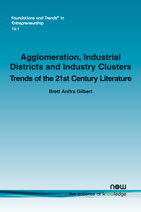Agglomeration, Industrial Districts and Industry Clusters: Trends of the 21st Century Literature
By Brett Anitra Gilbert, Rutgers Universuty, USA, bagilbert@business.rutgers.edu
Abstract
In a previous issue of Foundations and Trends in Entrepreneurship, small firms were commonly acknowledged as an important topic in the 20th century literature on industry concentration. Since the turn of the 21st century, startups have become a topic of significant prominence. Despite this fact, none of the recent literature reviews on industry concentration highlights their importance. Likewise, several other factors that have been identified since Marshall’s (1920) work, have received new attention with fresh perspectives in the 21st century literature. These topics have not yet been sufficiently explored in the literature. The purpose of this monograph is to review the early work of scholarship on agglomerations, industrial districts and industry clusters that has been published in the 21st century. This monograph explicates the prominent themes that emerged between 2000–2015, with the specific objective of highlighting the relationships of entrepreneurs, knowledge, networks and creative and high technology industries in industry concentration.
Agglomeration, Industrial Districts and Industry Clusters: Trends of the 21st Century Literature
Agglomeration, Industrial Districts and Industry Clusters: Trends of the 21st Century Literature reviews the early work of 21st Century scholarship on agglomerations, industrial districts and industry clusters and explores the context to the prominent themes that emerged between 2000 and 2015. A specific objective of this monograph is to highlight the role of entrepreneurs in the literature.
After an introduction, this monograph examines the potential of and for industry concentration. One of the factors identified in these articles as important for driving industry concentration is the entrepreneurship that operates in the region. Therefore, Section 3 offers a review of the literature that focuses on entrepreneurship and industry concentration. Section 4 examines the concentration of firms, buyers and suppliers within a region, which has offered opportunity for scholars to examine networks, relationships and industry concentration. Next, the author presents the research around why firms agglomerate and the noted benefit to firms that operate in networks, knowledge and industry concentration that was another theme that emerged in the 21st century literature. Whereas much of the industry focus of empirical studies published in the 20th century focused on manufacturing firms or those in the fashion industry, the 21st century noted a shift in industry focus with considerable discussion on creative and knowledge based industries; Section 6 focuses on the topics around creative and high technology industries and industry concentration. Each section concludes with thoughts on the scholarship that is needed to continue advancing the important topics on industry concentration. A summary of these thoughts is provided in Section 7.
